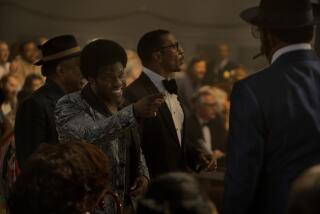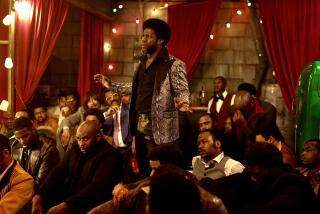Willing to fight for a role
THERE were a few intense moments in the boxing ring between actors James Franco and Tyrese Gibson during the production of “Annapolis.” And not just while they were acting.
“They came to blows a couple of times while they were rehearsing the scenes,” says Macka Foley, a veteran boxing trainer who whipped the cast into shape.
The boxing scenes are deftly choreographed with hundreds of moves and precise timing to simulate punches without actually having the actors get pounded. But who can be perfect in rehearsals?
“One actor would slip and hit the other one, and one would retaliate and get upset. When Franco [accidentally] hit Tyrese a couple of times, Tyrese would go into a rage. But when Tyrese hit him, he just sucked it up.”
“Annapolis,” which opens Friday, finds Franco playing Jake Huard, an Annapolis, Md., native who works in the shipyards but dreams of being accepted into the U.S. Naval Academy. Despite average grades, Huard is offered a position at the academy. Because he has a difficult time conforming to the school’s strict regime, his lantern-jawed commander, Lt. Cole (Gibson), thinks he’s not academy material. Before you can say “An Officer and a Gentleman,” Huard and Cole are at loggerheads.
Huard, though, unlocks his hidden potential when he trains for the legendary academy boxing tournament, the Brigade Championships. Of course, the drama’s one-two punch finds Huard and Cole duking it out in the ring.
Director Justin Lin says that Franco (“Spider-Man,” “James Dean”) and Gibson (“Baby Boy”) are as different in real life as their characters are in the film.
“James is methodical,” he says. “It is all about detail. He wants to live the character, and we would sit there and talk for hours about the character. Tyrese is naturally gifted when it comes to sports and stuff. But he’s more spontaneous. He comes in and just wants to do it. They had to memorize 250 to 350 punches per fight. If you slip, someone is going to get hit. If you ever played any sports, things do get heated. But it helped the movie.”
Boxing has been part of the academy’s curriculum since 1865; the first Brigade Championships were held in 1942 and have been a tradition ever since.
Scott Carson, the naval advisor on “Annapolis,” says boxing is mandatory at the academy, “because it is a way to overcome fears of getting hit and facing some of your [other] fears.”
Though no one has gotten severely injured during a match, says Carson, blood flows freely during the course of the tournament. “People who go watch the Brigades -- that is what they root for. [The blood] gets everybody fired up in the stands.”
The Brigade Championships sold Lin (“Better Luck Tomorrow”) on doing the film. The director and writer David Collard went to Annapolis, hung out with the current trainer and watched tapes of the matches
“Boxing is one of the very few things left in life that you know who you are as soon as you step into the ring,” says Lin. “Some of these guys [in the championships] aren’t the best boxers, but they just go at it. It is very clear that they are trying to find out in the ring who they are at that moment.”
LIN found the boxing tournament to be a metaphor for Huard’s personal growth during his plebe year at the academy.
“ ‘Annapolis’ is a very personal journey about this working-class kid trying to find out who he is, and every time he steps into the ring we get a sense of who he is as a person,” says Lin.
Foley, who also appears briefly as a referee, began working with Franco six months before production began; the other actors reported for training a month before cameras rolled.
“Not one of them had any experience,” says Foley. “That’s the way I like it because they don’t have any bad habits, so you can just mold them into trying to look like fighters.”
Every morning, he had the actors run three miles. “Then they would come into the gym and we would do bag work, speed work.”
Franco, he says, was the hardest working actor he had ever trained.
“He was sparring with real fighters,” says Foley.
“He did everything I asked him to do. He was a thin kid, so he started the nutrition program. He was eating more and eating the protein shakes. We started doing some weight work.”
Foley was on the set every day during the boxing sequences, as was fight choreographer Nick Powell (“Cinderella Man”).
Lin says it was “daunting and challenging” to bring the boxing sequences to life.
“Boxing is a big part of American cinema. I sat down and watched pretty much every boxing movie ever made. To be able to stylize visually a fight that is going to help serve the story of the character’s journey, it was very challenging.”
The director and Collard would work on the story for each boxing sequence. Then Powell would design the fight.
Lin used hand-held cameras for the close-up sequences in the ring.
“I was experimenting a lot with shutter speed. What happens is that it gives you less picture, but your brain is over-processing it and you see more.”
More to Read
Only good movies
Get the Indie Focus newsletter, Mark Olsen's weekly guide to the world of cinema.
You may occasionally receive promotional content from the Los Angeles Times.








